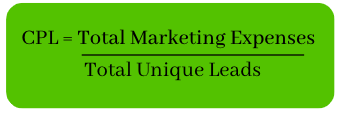Cost Per Lead
Definition
Cost per Lead is derived by computing all marketing expenditures and the total number of new leads that drive business revenue. The average cost for one lead which is based on marketing and advertising expenses is CPL.
Description
Cost per Lead Formula:

Cost per lead allows marketers to evaluate the effectiveness of marketing campaigns and cost. The success of an online business is determined by the profitability of the campaign.
In a Cost Per Lead model, first a business owner has to ask a third-party platform to place their advertisement on their site. After that when visitors click on the ad, they are redirected to your site.
On the website, the users can click on any action like “sign up for a newsletter”, “register for a live session”, or “buy here”.
Once a visitor clicks on the website, it becomes a lead. A common trick to track the lead is through a UTM code. A UTM code is attached to the landing page . This code helps Google Analytics to see which ad campaign referred a visitor to this page.
To bring the visitor up until this point, the amount of money spent on the site is the cost per lead.
Example
You spent Rs.600 on AdWords Campaign. The amount of money got you 35 leads which makes cost per lead Rs.17/-.
CPL= Rs.600/35 = Rs.17/-
To find the profitability, you must compare this price with that of the average product you have.
More Facts about Cost per Lead
These are the ways to reduce the cost per lead:
- Retargeting campaigns
At times, you may observe that your website has huge visitors but they leave the site without making the actual purchase. It can happen because of any reason, for example a complicated checkout process or the visitor being into the same business.
In such a scenario, instead of spending money to acquire new leads, you can drive revenues by pushing these leads through retargeting campaigns. They can see your ads on different sites and ultimately lead to increase in business revenues.
- Reconsider your demographics
Analyse your campaign reports and see whether the demographics you selected for the campaign was worth the investment or not? Find out the level of engagement and then alter the age and gender for which your advertisement will drive some revenue.
- Reduce the fields in the forms
Reduce the length of the form. Asking too many details from the users can leave them irritated. Ask for important information to prevent users from losing interest.
- Optimise your page loading speed
Work on the page load speed if you do not want the visitors to leave the site. Suitable site load time is 0-4 seconds. Higher the site load time, more will be the loss of revenue.
- Rethink your keywords
Analyse the high performing keywords. Clean the ones that are not driving any results for you even if it includes highly searched keywords. A quick tip to driving more traffic to the website is by targeting the long-tail keywords.
- Reduce the keyword bids
You may have keywords that are converting but the bid for them is high. Consider bringing the bid down as it gives you longer exposure on the search engine page with more clicks.
You can use Google’s automated bidding to match your goals of keywords hitting. The tool helps you to get the most conversions within budget.
Factors to consider before arriving at Cost per Lead (CPL)
These are the factors you must consider before arriving at the Cost Per Lead:
Variation in lead quality: The best way to consider the CPL is to divide how many leads match your critical quality indicators by the costs.
Channels for high volume of leads: Quality leads matter but channels that generate high-volume of traffic also matters. Invest in traffic sources that match your expectations.
Competition: Understand that every customer that you got in your kitty is a customer lost by the competition and vice versa. Try to know which platform will suit the most for your brand to get the target audience.
Marketing overhead expenses: Consider all the marketing overhead expenses. This includes the amount you spend for creating the marketing content and divide it by the number of leads you generate.
Optimise follow-up: Optimise the follow up campaign. Once the leads have shown interest and made a purchase, evaluate how good you are at handling the leads. Make the follow-up perfect as it offers a connection with your brand.
Think about Customer Lifetime Value: Predicting a lifetime value of the initial lead enables you to predict the return on the investment made. You can optimise the campaigns to drive results with leads that have higher lifetime value.
Conversion rate of landing page: Converting landing page will increase the return on investment made.
FAQs
What is a good cost per lead for Facebook?
According to the data applicable globally, the average cost per lead for Facebook Ads is $19.68. It ranges from $12.91 for food and drinks to $56.89 for news.
Should the cost per lead be high or low?
The cost per lead should be low.
The higher the cost per lead makes the ad campaign less effective. Lower the CPL, more ideal the marketing is.
How do you monitor the cost per lead?
Cost per lead is simple to monitor. Calculate the number of leads and the total marketing spends within the same time frame, to monitor the cost lead.
How is Cost Per Lead different from Cost per Acquisition?
CPL is the total cost incurred to generate one lead. On the other hand, Cost per Acquisition is the total cost of generating a new closed deal.





Comments
nice